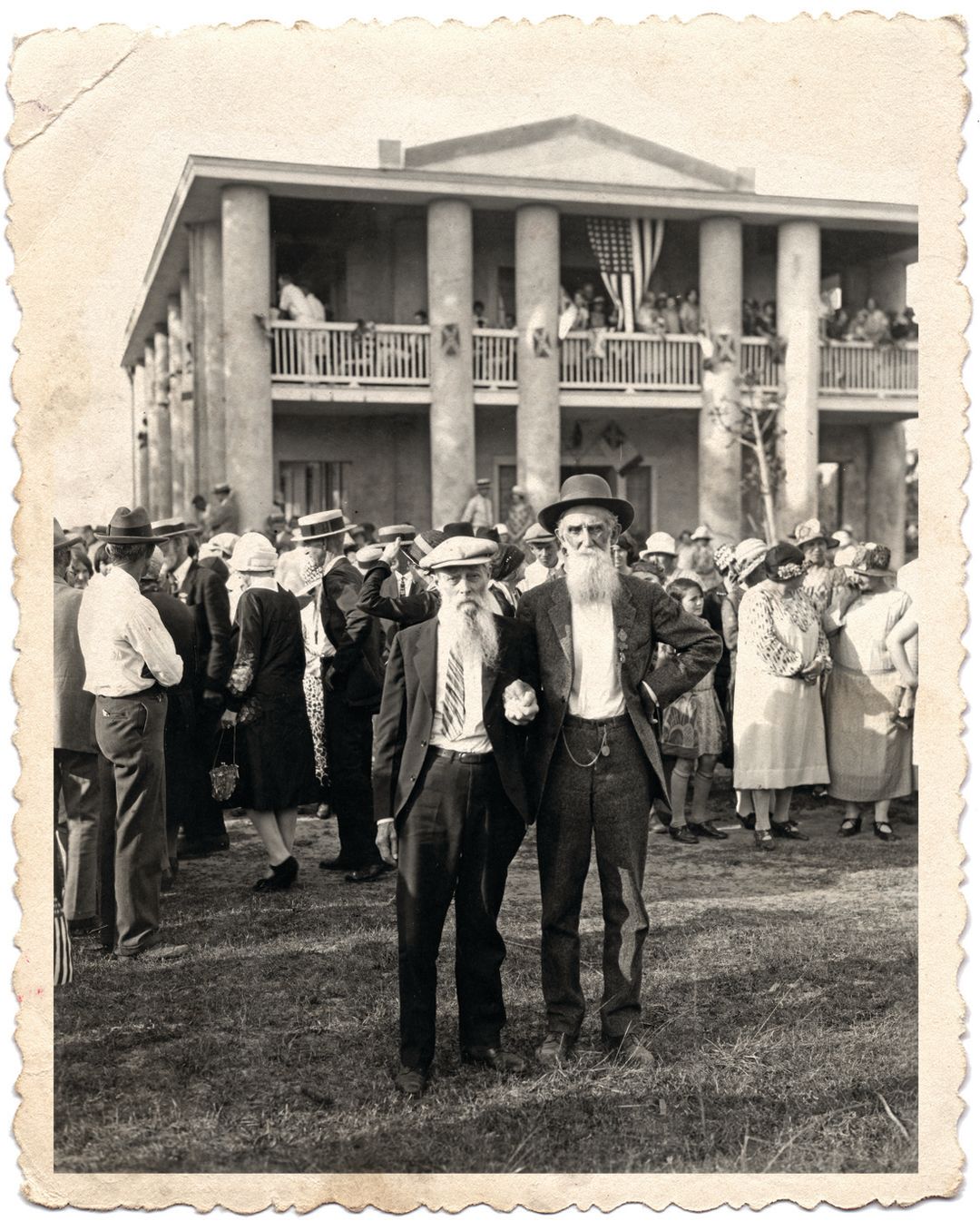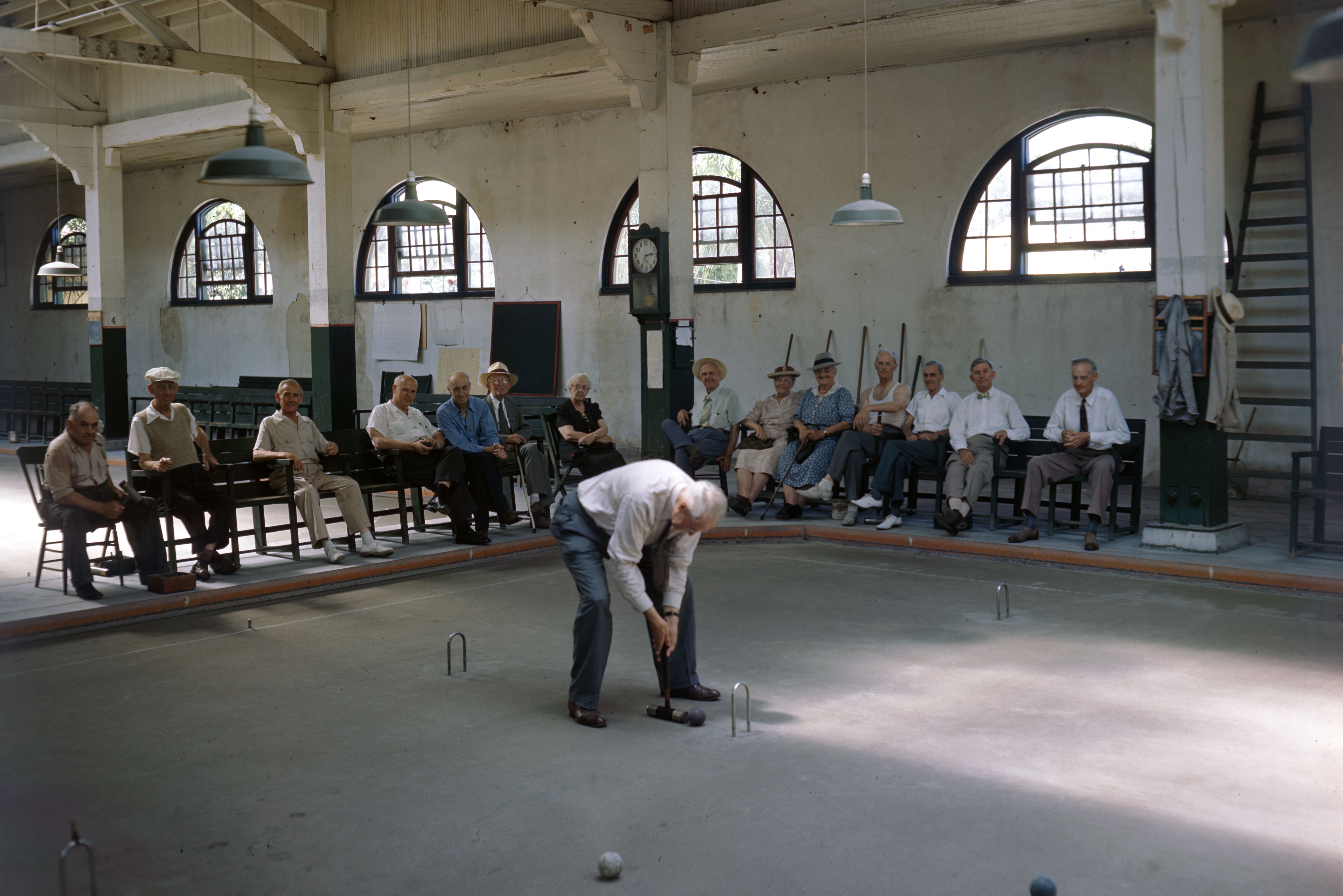Revisiting the Confederacy at Ellenton's Gamble Mansion

Confederate veterans at the Gamble Plantation in the 1920s.
WHEN I RECENTLY WROTE about what a peaceful old Southern town Bradenton is, I debated whether to mention the Confederate war memorial next to the courthouse. Everybody knew it was there but didn’t talk about it. For me to bring it up seemed tactless. Besides, race is the hardest thing to write about. You never get it right. You get preachy or condescending, or end up sounding racist yourself, with your upbringing and political views pushing you along to some misstep.
But bring up the memorial I did, and now look what’s happened. Demonstrations, arrests, and a public debate as to what do to with the monument. I’ve been told by several people that I’m responsible, which is, of course, ridiculous. It was always a ticking time bomb waiting to go off.
The latest plan seems to be that the monument, an obelisk with some soldiers at the base and some words about “the noble traditions of the South,” may be moved to the Gamble Plantation, that Civil War-era mansion in Ellenton, which was donated by the Daughters of the Confederacy to the Florida Park Service in 1925. I had been to the Gamble Plantation maybe 25 years ago and had little recollection of what it was like. But now that its role as keeper of the Southern flame may be solidified, I decided to go to see if it was a suitable resting place.
If the idea is to put it in a place where nobody will see it, the plan is a complete success. I was the only person there. Granted, it was the middle of the afternoon in the middle of the week, but instead of busloads of third-graders here on a history field trip, there was just me.
Actually, there was also a nice lady in the Visitor’s Center who sold me a ticket and told me to be on the front porch at 3. This gave me 10 minutes to check out the exhibits in a large room with stuff in glass cases. It was mostly about sugar cane cultivation and the Daughters of the Confederacy, of which my dearly beloved grandmother was a card-carrying member.
I then meandered over to the mansion itself, a most impressive building in a primitive Greek Revival style. Around 3:05 a park ranger drove up in a pick-up. I got the impression that he had just been woken from his nap by the ticket lady calling to say, “Get over here! We got a visitor!”
It was a pleasant way to start a tour, sitting in a rocking chair on the porch of an antebellum mansion while the park ranger delivered his spiel. Unfortunately, it turned into a case of too much information. The ranger explained that the early white settlers of Florida, Mr. Gamble included, had been promised free land if they would come to Florida, arm themselves, and fight the Indians. Yikes. Killing Indians and enslaving black people. Talk about white supremacy.
The house itself is impressive. Not real big like the Southern plantations in Gone with the Wind, but charming in its own way. It’s only one room wide to allow for cross-ventilation, and the tabby walls—you learn a lot about tabby, a kind of concrete made with oyster shells, on the tour—are two feet thick.
The ranger took me through the entire house and explained what life was like back in those days, when the nearest store was 220 miles away—by boat. The kitchen, as was the custom, is a separate little building connected to the back of the house. The other rooms had high ceilings and were gracious but certainly not grand.
What keeps the Gamble Mansion from being just another Southern plantation is the drama that took place there. In May 1865, the Confederacy had just fallen, and Judah P. Benjamin arrived, fleeing from the Yankees with a price ($40,000) on his head.
Benjamin is one of the great enigmas of American history. A Jew, he was known as “the brains of the Confederacy.” He served as both Secretary of War and of State, and came close to getting England and France to recognize the Confederacy, which could easily have changed the outcome of the war. Towards its end, he advocated freeing the slaves and enlisting them in the Southern army. This proposal was even passed by the Confederate Congress but by then—March 1865—it was too late.
For such a towering historical figure, Benjamin is little remembered today, even by historians sympathetic to the South. The Gamble Mansion may be the site of his only memorial. One reason, of course, is anti-Semitism. Another is, according to a number of historians, he might have been gay. He lived apart from his wife for 40 years and had a close, gossipy relation with Varina Davis, Jefferson Davis’s wife. To me the most telling detail, though, is the fastidious “almost feminine” attention he devoted to planning his daughter’s wedding.
The most evocative part of the tour comes when you walk into the bedroom Benjamin occupied. It’s at the front of the mansion, and in the old days there was a clear view down to the Manatee River. At any moment, a Yankee gunboat might show up. Fortunately for Benjamin, he got away just in time. A boat took him down to Whitaker Bayou in Sarasota, where another boat picked him up and took him to Bimini and freedom. He ended up in England and started a whole new career as a prominent lawyer, another reason the Confederates hated him. They had to stay here and suffer in shame and defeat. He became a multimillionaire and the toast of London. He wound up as Queen’s Counsel and wrote a book on contracts that has become part of our—and Britain’s—legal system.
As I stood on the same balcony and contemplated Benjamin’s journey, it struck me that the Gamble Plantation is a perfect storm of race and prejudice. I don’t mean this in a scolding way; I mean it in a historic way. It’s got everything. White people, black people, Indians, Jews, white supremacists and even white gay Jews. They were there for various reasons and under very different circumstances, but they all left their mark and their stories.
Or did they? What about the slaves? In the Visitor’s Center you find a little information about them. There were anywhere from 140 to 180 at any given time, and two documents list their names. One I couldn’t read but the other was quite clear. Some had first and last names, others just first names.
But where was the exhibit about them? The display case that showed what their lives were like? I couldn’t find it, but I assumed I would learn more on the tour.
Wrong. They were virtually absent from the park ranger’s talk. On only two occasions did they come up. One was when he demonstrated how the old rope beds worked. “Every night a slave would tighten the ropes for you,” he said. OK, I thought, and we moved on to the chamber pot. “And every morning the slaves would empty the chamber pots,” he explained.
That was about it. The slaves’ function was to empty the white people’s chamber pots. Before, I was concerned that they weren’t busing in schoolchildren to learn about history. Now I was glad they weren’t.
Maybe it’s time for the State of Florida to rethink how it is presenting history at the Gamble Plantation. At the moment, it would be an unpleasant experience for African-American schoolchildren. Everybody should be included, and not just from a white-centered point of view. After all, everybody is paying for its upkeep.
And as for the Daughters of the Confederacy, I just remembered something. My grandmother quit. Or, rather, dropped out. It wasn’t out of high moral purpose, though. It turned out the meetings conflicted with her bridge club.



